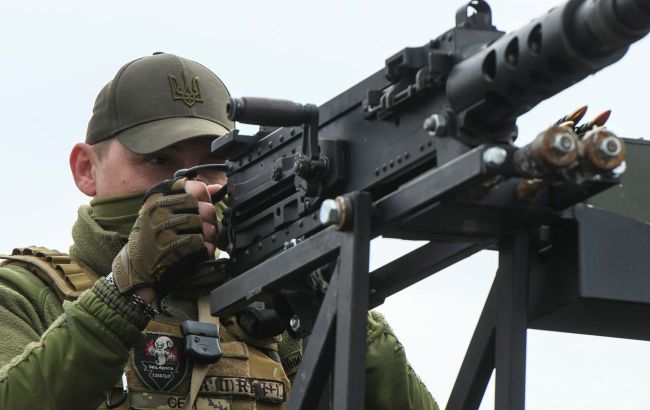Maximum 140 missiles: Expert explains tactics of Russia's double strike and names risks
 Illustrative photo (Getty Images)
Illustrative photo (Getty Images)
Over the past two days, Russia has been launching combined strikes against Ukraine, using various types of missiles and Shahed drones. The goal of these attacks is to disorganize and disorient Ukrainian air defenses as much as possible while inflicting maximum damage on targets of interest, Oleksandr Musiienko, head of the Center for Military-Legal Research.
Purpose of Russia's recent combined attacks
According to him, a key characteristic of these strikes is that drones were launched and flew during the missile attacks.
"Yesterday's shelling was more extensive. Today's was smaller. They divided the attacks into two phases. This has happened before. I want to remind you, for example, that the enemy attacked Ukraine on December 28, 2023, and then again on January 2," Musiienko recalls.
He emphasized that the drones did not just precede the massive missile attack but were active during it. This was not just to detect and exhaust Ukrainian air defenses but also to force Ukraine to use more of its missiles.
"We understand that a drone, like a missile, can appear the same on radar. It's a target for air defense systems, which may trigger a response and expend missiles—something the enemy is interested in," Musiienko explains.
Another detail he points out is that the enemy is attempting to strike single targets with a large number of drones and missiles.
"According to Russian command, concentrated strikes like these might cause drones or missiles to be intercepted over or near an energy facility, triggering damage or even fires, leading to further destruction," Musiienko says.
Moreover, Russia seems to be using Shahed drones that fly at higher altitudes, making them less vulnerable to Ukrainian mobile fire teams, which sometimes struggle to hit them with large-caliber machine guns because of their altitude, the expert adds.
How many missiles can Russia launch in a single massive strike?
Musiienko also said that the missiles are changing trajectories, and the Russians are using decoys and different types of missiles simultaneously.
"This creates significant pressure. I’m not sure that even some NATO countries' air defense systems could protect against such attacks. So, the fact that Ukraine can repel these attacks thanks to its air defense system shows the high level we've achieved," he emphasizes.
The expert also noted the intervals between recent massive strikes.
"The last attack involving strategic aviation and a significant number of missiles took place on July 8. The next one was on August 26. So, we can say that it took the Russians a month and a half to accumulate the missiles needed for this strike," Musiienko says.
According to his calculations, Russia’s production capacity and capabilities currently allow it to manufacture about 90 to 100 missiles per month. This includes cruise missiles, naval-based missiles, Iskanders, and Kinzhal missiles.
"Sometimes, fragments of these missiles indicate they were very recently manufactured. So, with pauses of a month and a half to two months, their maximum capacity seems to be 120 to 140 missiles," Musiienko says.
In his view, the enemy cannot exceed this limit, as previous attacks have shown.
"The next step will be either to accumulate missiles again for two months and then launch another massive strike or distribute them over 3-5 attacks," Musiienko adds.
Why is enemy using so many Shaheds, and what are risks?
Additionally, Musiienko stressed the importance of monitoring the situation with the use of Shahed kamikaze drones.
"There is a possibility that Russia might start purchasing Shahed-101 drones from Iran, which are equipped with electric motors and are thus silent. This would be another challenge, but Iran has likely already supplied such drones to Hezbollah, so it's possible they could be provided to Russia as well," the expert believes.
However, he does not think the number of Iranian kamikaze drones used by the enemy has sharply increased.
"They are launched within an average margin of error. Perhaps there will be slightly more this month than last, but it's not a constant increase to over 100 Shaheds in a single attack. On average, it's 20-30-40 drones. So, there's no significant surge here. They just used them more massively this time to increase the impact of the attack on us," Musiienko concludes.
Massive attacks on Ukraine on August 26 and 27
On the night of Monday, August 26, 2024, Russian forces launched a massive combined strike on Ukraine's critical infrastructure, particularly targeting the fuel and energy sectors. They used various types of air, land, and sea-based missiles, with a total of 127 missiles and 109 strike drones. Ukrainian air defenses managed to shoot down 102 missiles and 99 drones. RBC-Ukraine has detailed this attack and its consequences in a separate report.
Additionally, Ukraine came under another combined attack the following day. This time, the enemy used 81 Shaheds and 10 different types of missiles, with Ukrainian defenders shooting down 60 drones and five cruise missiles.

